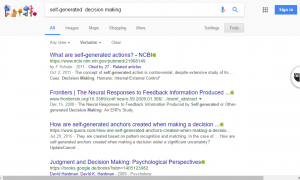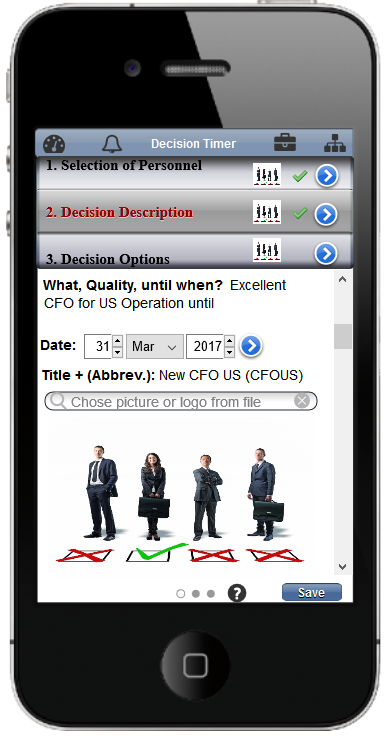Language and concepts are very important and instrumental in the way we think and act in this world!
Analyzing our language and its use therefore yields very interesting insights about ourselves and our actions, particularly in the context of decision making.
Current state
Last week I started this analysis in my German article “Fremdwort “Entscheidungsterminierung” – Lektion 1 aus “Decision Timing” Buch” which can roughly be translated as “Alien concept “Decision Scheduling” – Lesson 1 from “Decision Timing” book“.
One of the introductory ideas of this article was to show that in German the term “Entscheidungsterminierung” (translation “decision scheduling”), while easily understandable, has no practical, general relevance for the German public at large. This assertion can easily be deduced from a simple Google search, which returns only three results instead of several thousand.
If you carry out a very similar Google search in English, using the same search term “decision scheduling” or longer terms like “self-initiated decision making” or “self-generated decision making“, you will get the same results for the English speaking world as above, with only a handful or no verbatim results.

Google Search March 20th, 2017 for “self-generated decision making”
The point that I therefore like to stress and document with these results here:
“It is not common practice for us in Germany or in the English speaking world to schedule or time important personal decisions in a proactive and self-initiated fashion.”
I expect that many of you might quickly disagree and object that of course you consider and plan many important personal events like weddings, having a child, buying a house, planning your career etc. so surely the above statement is not true. But if you look at my statement more closely and the process you actually use to make your decisions, I think that you will have to agree that you do not really consider or plan the time you need to actually prepare and develop your decisions. In consequence you do not set aside any time or perform any scheduling or planning activity for your decision making.
The Google search results for the above terms clearly show this!
Most of the time the decision process is taken for granted, or is ignored, because the decision is already implicitly taken or outside factors leave you no other choice.
In other words, your attitude to many important decisions in your life might well be:
“I have no choice anyway!”
While I, as a decision coach, would personally strongly disagree with you, today’s “life sciences” to a large extent would sympathise with you. According to Yuval Noah Harari the historian and author of “Sapiens: A Brief History of Humankind” and “Homo Deus: A Brief History of Tomorrow“: “The word freedom simply has no meaning in the life sciences of today.” Very simply put, life sciences to a large extent have put away with the concept of free will and have replaced it with the dogma of: “Organisms are algorithms.”
Being also an engineer, I can follow the argument that biologists, chemists and geneticists put forward for some of their findings and perspectives. On the other hand, from my perspective as a practicing coach, similar to Harari being a scholar and historian, we with many psychologists and neuroscientists have to point to the great limitation and oversimplification that lies in the above dogma.
Consciousness and subjective experience is just not accounted for in the simple idea of “Organisms are algorithms“.
On a practical level, most of us are well aware that the above is just an academic discussion, and that life sciences (and anyone else for that matter) cannot and should not relieve us from our personal responsibility to take timely, appropriate and sustainable decisions.
As I indicate in my new book “Decision Timing: More Awareness, New Insights, Smarter (Method & Tool assisted decision making)” many of us, particularly an estimated 70% of students consider themselves procrastinators and engage in acts of procrastination.
This means, they and we, tend to delay and postpone many important activities and decisions in our lives.
This is partly due to the fact that there are just so many other things that we find more interesting, easier and more fun to do than to take important decisions.
Added to that, we generally underestimate the time, effort and process required to make important decisions.
Making things even worse, apart from general procrastination (delaying) there are so many other factors like:
- Stress
- Lack of proper decision making methods and processes
- Bad mood
- Low energy
- Not enough willpower
that tend to get into our way of taking enough care and time to make better decisions.
In consequence we decide things randomly, unstructured, automatically, intuitively and when things are very important not at all or very late.
Misguided and oversimplifying the idea of “live in the moment” we ignore the limited time resources and opportunities we have to live, change and improve our lives.
To put it very succinctly:
Without clarity and discipline, we do not have a future!
Let us see what we can do about this in more detail.
* *
Future state
There is a very interesting study by Florence J. M. Ruby , Jonathan Smallwood, Haakon Engen and Tania Singer published 2013 with the title: “How Self-Generated Thought Shapes Mood—The Relation between Mind-Wandering and Mood Depends on the Socio-Temporal Content of Thoughts“.
With their research, the authors found “that the emotional content [of self-generated thought] could strongly predict subsequent mood (e.g. negative thoughts were associated with subsequent negative mood).
However, this direct relationship was modulated by the socio-temporal content of the thoughts: thoughts that were past– and other-related were associated with subsequent negative mood, even if current thought content was positive.
By contrast, future– and self-related thoughts preceded improvements of mood, even when current thought content was negative.”
In other words, our ability, interest and preparedness to look into the future not only improves our ability to change the future, in the way we want, it also improves our mood, even if our current thought content is negative.
Engaging in self-generated thought (SGT) can have many short term and long term benefits particularly when “focused on events that may occur in the future. … Consistent with the notion that SGT conveys a long-term benefit, individuals who mind-wander under non-demanding circumstances tend to delay gratification and generate more creative solutions to problems“.
The authors conclude:”Presumably people use SGT [self-generated thought] to take advantage of the benefits that prospection affords: they use previously-acquired knowledge to prepare for events that have not yet happened, so that their actions can be more effective if the opportunity to act ever arises.”
So intention to act is very important and necessary to improve our mood and to set us into motion to find and use the appropriate methods, processes & tools for decision making.
Taking into account what I have developed above you will probably agree with me that self-generated thought with a future focus is the perfect preparation for a self-initiated decision maker.
But what can we do to overcome procrastination and other distractions that might get into the way of our progress in making more appropriate and timely decisions.
Let me introduce a second study, this time by Dan Ariely (while at MIT) and his colleague Klaus Wertenbroch from INSEAD. The title was “Procrastination, Deadlines, and Performance: Self Control by Precommitment” (Psychological Science 2002).
The two scientists were interested to study:
1) How much students are aware of their own procrastination;
2) What would be the best strategy to overcome procrastination; and
3) What result procrastination would have on their academic grades.
Three different groups of students were compared with respect to their deadlines of handing in 3 academic papers during a 12 Week period and the respective grades they received for these papers.
Group 1 was allowed to choose by themselves when to hand in their paper, the only provision being that they had to commit to a date, that could not be changed afterward, and they were penalized if they handed their papers in late.
Group 2 was allowed to hand in their 3 papers within the 12 weeks whenever they wanted, so they had full flexibility.
Group 3 were given three deadlines (in the 4th, 8th and 12th week) with no flexibility.
These were the findings:
- Group 1 made good use of the opportunity of being able to schedule their deadlines themselves, and in consequence, spaced out the deadlines across the whole semester.
- Group 3 achieved the best grades followed by Group 1.
- Group 2 had the worst results.
- Students in Group 1 that understood and were aware of their personal procrastination chose their deadlines wisely and thereby achieved the same grades as Group 3, i.e. the best grades.
- Students in Group 1 that did not understand their own procrastination did not do as well, thereby lowering the total score for Group 1
The most interesting finding to underline is the following:
”Simply offering the students a tool by which they could pre-commit to deadlines helped them achieve better grades”.
If we transfer this basic finding to decision making, we can quickly understand how the new tool, the decision timer, that I present in my above mentioned book, can help to make more timely and more appropriate decisions.
To better understand how a dedicated tool like the decision timer (described in the associated process of decision timing) can help you to proactively time and schedule your decisions, let me introduce a metaphor.
The metaphor is “archery”. In the first step of decision timing you formulate and define your decision. This is your goal, represented by the target that the arrow of the archer is intended to hit. To have a realistic chance to precisely and successfully strike your target, you need to have a sound footing, to be well balanced and relaxed.
In the second step, you enter into a state of pretension, by setting a firm date by which you are going to take and execute your decision. This will allow you to keep your decision well in sight, all the time, and to perfectly focus your energy, to succeed in whatever you are trying to achieve.
This is decision timing or self-initiated and proactive decision making!
If you want to know more about decision timing and the decision timer please refer to my new book: “Decision Timing: More Awareness, New Insights, Smarter (Method & Tool assisted decision making)” now available on Amazon as a Kindle e-book.
If you like to get decision coaching or instructions on decision timing, please contact me here.
Written by Felix Schürholz, March 22nd, 2017, www.decisiontiming.com


Check this out too: How to overcome procrastination with “Self-Continuity” AND “Self-Improvement” http://decisiontiming.com/how-to-overcome-procrastination-with-self-continuity-and-self-improvement/
Timing is great, but do you know which timing is best for you? http://decisiontiming.com/simple-tricks-to-improve-your-decision-making-1-choose-optimal-time-of-day-decision-timing/